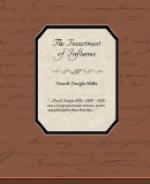If ages ago the sages said, God is not in the earthquake, nor in the storm, but in the still small voice, now science reaffirms the declaration that omnipotence is revealed not so much through awful cataclysms and earthquake forces as through the silent agents and hidden processes that make the plains to be fruitful and hillsides to be rich in corn. In the past astronomy has been the favorite science, emphasizing the distant stars and suns. The science of the future is to be chemistry, emphasizing atoms and elements. Journeying outward in pursuit of the footsteps of God, advancing upon his distant and dizzy march, man’s vision faints and falls upon the horizon beyond which are indiscernible splendors. Journeying inward upon the wings of the microscope, we shall find that there is another realm of beauty beyond which the utmost vision of man cannot pierce. For before the microscope “the last discernible particle dies out of sight with the same perfect glory on it as on the last orb that glimmers in the skirts of the universe.” If God is throned in the clouds He is also tabernacled in the dewdrop and palaced in the bud and blossom.
The history of nations and individuals teaches us that the greatest gifts are poor and empty and the most signal talents worthless if the small things be not done, the two mites be not given. For life is marred by little infelicities and ruined by little errors. The broken columns and marble heaps in lands where once were cities represent destructions not so much through tornadoes and earthquakes as through small vices and unnoticed sins. In modern life also, journeying through city and forest and field, the economist returns to tell us that life’s chief wastes are through little enemies and foes. It is a minute bug that steals the golden berry from the wheat; it is a tiny germ upon the leaf that blights the budding peach and pear, it is a rough spot upon the potato that fills all Ireland with fear of famine; it is a worm that bores through the planks of the ship’s hull and alarms old seacaptains as approaching battleships could not.




